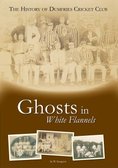
Club Book and History
Ghosts in White Flannels - The History of Dumfries Cricket Club
The book describes the history of the Club, since its inception in 1853 as the Dumfries Cricket and Bowling Club, across 184 fully illustrated A4 pages.
Editions of the Book are available for purchase directly for £12 or for £15 by post.
Reviews
Cameron Munro (Scottish Heritage Cricket) - "the best Scottish Club history book".
Malcolm Cannon (Then Cricket Scotland CEO) - "excellent book".
Purchase
Copies can be obtained at the bar at the Clubhouse, Nunholm, and from Solway Print, 11 Catherinefield Industrial Estate, Dumfries DG1 3PQ (01387 262 960, info@solwayprint.co.uk ).
Description
The book describes the different eras of the Club and tells the story of cricket at the Club as part of the sporting and social history of Dumfries, and of Dumfries and Galloway, and of the sport in Scotland and the United Kingdom.
The topics covered in the book range from the first Club ground at Milldamhead in Dumfries before the Club, AND its pavilion, moved to its second, and current home, at Nunholm, to the Club’s greatest achievement of winning the Western Premier League for the first time in 2012.
The present day multi-sport nature of Dumfries Sports Club, with cricket, tennis and squash, is reflected in the Cricket Club’s association through the years with a range of sports including the beginnings of Queen of the South football club, Scotland’s first ever lacrosse match (played by Canadian Indians), the Dumfries Annual Games, and why Quoits was banned.
The history of Cricket itself is also touched upon with the exploits of Club Captain A.G. Steel whose name is on the Ashes Urn that is fought over in England Australia Test series. The Wisden article about him in 1915 described him thus "Taken all together in his prime as an all-round cricketer AG Steel had good claims to be considered the best in England, always excepting W.G. Grace".
It describes the tribulations and triumphs of a local club continuing through the 19th, 20th and 21st centuries, and two World Wars, from the death of a 19 year old player a month into WW1 to the Club hosting India in an international match against Scotland.
However the book also describes the many individuals, players, and characters, who have sustained the Club beyond 160 years with many now long gone, the “Ghosts in White Flannels”.

